CONDUCTORS
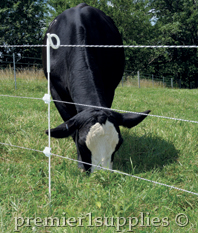
Three energized ropes supported by a step-in pigtail post with 2 adjustable pigtail clips.
What Premier offers…
| • |
More experience. We were among the very first to offer and promote electrified rope. |
| • |
Knowledge. We specialize in electric fences. We use them. Farm stores and other catalogs don’t. |
| • |
Widest range of options—IntelliBraid, EnduraSoft, IntelliRope PE, IntelliTape, etc. So you can choose a product for your specific situations and needs. |
| • |
Ropes and tapes that combine conductivity, durability, visibility and mildew resistance. Choice of either twisted or braided ropes. |
| • |
Lowest costs for similar quality. |
It’s almost a given that if someone is selling rope for less than Premier, the rope is inferior in diameter, conductivity, filament quality or visibility. (Check the labels for yourself.)
Not sure what type of fence
you need?
Let us help you. On our website you can view our products with details and information about our many fencing options: Temporary, Semi-Permanent and Permanent Fences
We also have fence consultants in-house to help you with any questions you may have.
STEP-IN POSTS
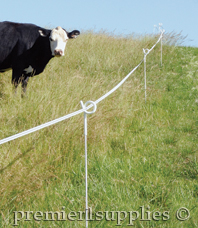
For cattle one strand of tape (or rope) is enough for a subdivision fence. Set conductor height at or below nose level.
Support fences in all situations
PigTail Posts
| • |
Ideal for strip-grazing. |
| • |
Easy to carry and quick to insert in soil. |
| • |
Simple to install/remove conductors. |
| • |
Holds all sizes of conductors. |
| • |
Double spikes make installation easy. |
| • |
Snap-on PigTail insulator (sold separately) enables posts to support up to 4 strands of rope, twine or narrow tape. |
| • |
Available in 35" or 45" heights. |
Step-In FiberRod Posts
| • |
Coated with urethane and UV resistant coating. |
| • |
Pencil-pointed 3/8" diameter. Gray in color. |
| • |
Features the step-in footplates to enable users to push them into medium soils with their feet. You can also use a hammer to gently tap it into hard soils. |
| • |
For extra clips purchase the Snap-on Harp clip for holding all types of low-tension conductors. |
| • |
Available in 36" or 48" heights. |
PowerPosts
| • |
Very easy to use but less durable than PigTail posts or Step-In FiberRods. |
| • |
All PowerPosts have multiple front-loading clips with angled entry for tape, twine or wire. |
| • |
Made of plastic. |
| • |
Green posts are the same as the gray, but blend into the background of gardens. |
| • |
Available in 21", 35" and 48" heights. |
ENERGIZER OPTIONS
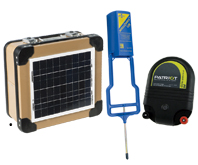
Premier PRS 50, IntelliShock 12B and Patriot P5
Which unit is right
for you?
The size, in pulse energy output (range from .5 joule to 2 joules), depends almost entirely on the length of the fence and the weed contact that will occur along the fence line.
Contact Premier or call 800-282-6631 to speak with one of our fence consultants to help you determine the best energizer for your needs.
You can also view our energizer comparison charts online or in Premier's fencing catalog for help in choosing an energizer.
Contact Premier or call 800-282-6631 to speak with one of our fence consultants to help you determine the best energizer for your needs.
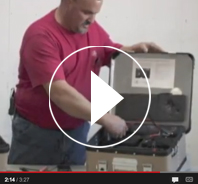
If it's the end of your fencing season, you'll find our video above on how to properly store your energizer and batteries for winter helpful, with instructions and tips the folks at Premier have learned by experience.
|
 |
 |
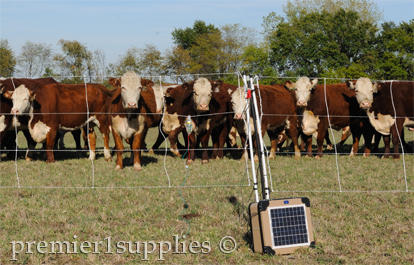
Using Cattle QuikFence™ to subdivide a pasture for grazing. The herefords in the photo belong to Jeremy H. of Brighton, IA.
Stored Feed and
Stockpiled Forage
Looking for good advice on how to save $$ for this winter's feed costs? The folks from University of Missouri and Oklahoma State University have provided several articles on how to stretch your cattle feed dollars. The information is useful whether you're feeding your Hereford breeding stock or the Jersey calf you picked up at the local auction barn.
EXTENSION NEWS
Beef Cow Herd Calendar
By Oklahoma Cooperative Extension Service
This Beef Cow Herd Calendar was developed as a production practice and management guide for Oklahoma cattle producers. Local adjustments and adaptations in some areas may be necessary due to differences in types of grass and cattle, amount of rainfall, length of growing season or other factors. Assistance in making these adjustments for local farms is immediately available to cattle producers by calling or visiting the county or area Extension office.
JANUARY
Fall Calving
| 1. |
If a high percentage of cows return to heat after 40 days of breeding, have bulls rechecked for fertility and cows and bulls examined for reproductive diseases by a veterinarian. Change bulls if necessary, and re-evaluate the nutrition program.
|
| 2. |
Assign yearling bulls 15 to 20 cows, two- and three-year-olds 20 to 25, and aged bulls 25 to 40.
|
| 3. |
Continue supplemental feeding of bulls, cows, and calves. If small grain pasture is available, adjust supplemental feeding to requirements of cows.
|
| 4. |
If a creep feeding program is desired, limit-feed a high protein (30-40%) supplement, such as recommended in the Oklahoma Silver program. See your local Extension Agricultural Educator for further details.
|
Spring Calving
| 1. |
Continue supplemental feeding of pregnant females, so that they will be in good condition at calving.
|
| 2. |
Check first calf heifers (due to calve) several times daily for possible calving difficulties.
|
| 3. |
Feed in evening to encourage daytime calving.
|
| 4. |
Weigh yearling heifers, adjust weights, and calculate ratios. Base selection on both weaning and yearling information. Also select for good disposition and temperament, sound feet and legs, and dam’s udder structure.
|
| 5. |
Purebred breeders should send performance data to the national breed association office.
|
| 5. |
Review details listed under March for herd sire selection.
|
| 6. |
Check body condition score on heifers and cows.
|
General Recommendations:
| 1. |
Water is as important in the winter as it is in the summer. Keep tanks or other water supplies open by breaking ice at least daily or by using a heater or freeze-proof stock tanks.
|
| 2. |
Provide free choice mineral mix year around (a commercial mix or one part salt and one part dicalcium phosphate).
|
Read More »
EXTENSION NEWS
Reducing Winter Feeding Costs
By Oklahoma Cooperative Extension Service
Daren D. Redfearn
Extension Forage and Pasture Management Specialist
During periods of reduced forage growth (typically winter), livestock must have an alternative source of feed. However, producers spend an extraordinary amount of money on providing these alternative feeds. Analysis of data from the Standardized Performance Analysis (SPA, Fig. 1) survey indicates that there is wide variation in input costs associated with livestock production systems.
Regardless of whether a producer falls into the low-, mid-, or high-cost category, feed costs account for approximately 26 percent of the cost of production. Feed costs, as demonstrated by the SPA data, reflect the second highest annual cost associated with cattle ownership, and second only to the original purchase price of the cattle. The use of supplemental feed (hay or concentrate) may be beneficial to livestock, especially for growing animals, animals in the latter stages of gestation, lactating animals, or during periods of reduced forage growth (i.e., drought, winter).
Most producers could substantially reduce their winter feed costs by carefully considering their forage production management practices. Reducing input costs associated with hay production and feeding (regardless of whether the hay is produced on-farm or purchased off-farm) or concentrate-type feeds, can help to improve the profitability of livestock production systems.
This publication discusses management practices that can reduce the costs associated with livestock winter feeding programs.
Read More »
WINTER FEEDING SOLUTIONS
Feeding Beef Cows in Winter
By Robert Kallenbach, Professor, Division of Plant Sciences, University of Missouri
Feeding hay to cattle is expensive. The expense of producing, making and feeding hay accounts for approximately 50% of the cost to produce beef and 30% of the cost to produce milk in the Midwest. By using winter pastures to extend the grazing season, producers can reduce the amount of hay they feed and in doing so substantially reduce input costs.
Stockpiled tall fescue.
A popular winter pasture in the Midwest is stockpiled tall fescue. The biggest advantage of stockpiled tall fescue is its low cost. For instance, dry beef cows can be maintained on stockpiled tall fescue for about 40 cents per head per day compared to over $1.25 per day for hay. For cow-calf operations, this is probably the cheapest way to winter dry, pregnant cows. It works pretty well for fall-calving cows also. Another advantage of stockpiled tall fescue is that it weathers well. Tall fescue leaves have a waxy layer that helps them stay green nearly all winter. As a result, the quality of well-managed stockpiled tall fescue is often better than most grass hay.
Tall fescue pastures to be stockpiled should be grazed or clipped to a 3 or 4-inch stubble in early to mid August. Immediately following this, 40 to 80 lb./acre of N fertilizer as ammonia nitrate should be applied to stimulate fall growth. It is better to apply the N in mid-August when it is dry than to wait until the first autumn rains to apply the N. Waiting until mid-September to apply N generally will reduce forage yield by 20 to 40%. Producers of stockpiled tall fescue need to maximize the number of days in September and October that growth occurs. And applying the N early does that.
After the pastures have been fertilized, little needs to be done until winter grazing is needed. Once you decide to utilize the feed, strip grazing works best. Utilization rates for conventional grazing are approximately 30% versus 70% for strip grazing. Typically, allocating a three day supply (or less) of forage to animals will maximize utilization. Given the high cost of other winter feeds (i.e. hay or supplemental feed) maximum utilization is a must. Systems need not be complicated to be effective. Poly tape, step-in posts, and portable chargers can help make systems affordable.
Read More »
|
|